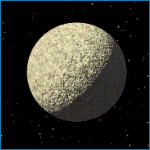| Proper Name | Mercury | | Orbital Period | 88 days | | Distance from the Sun | Semi-Major Axis: 57,909,000 km (0.39 AU)
Perihelion: 46,001,000 km (0.31 AU)
Aphelion: 69,817,000 km (0.47 AU) | | Eccentricity | 0.2056 | | Rotation Period | 1,407.5 hours | | Diameter | 4,878 km | | Mean Surface Temperature | 445 K (172°C) | | Moons | None | | Parent star | The Sun, yellow dwarf star | | Other planets in this system | Venus, terrestrial planet
Earth, terrestrial planet
Mars, terrestrial planet
Jupiter, gas giant
Saturn, gas giant
Uranus, ice giant
Neptune, ice giant
Numerous dwarf planets, asteroids and other bodies
| | Notes | A rocky, heavily cratered world, Mercury is the innermost of the Solar System's planets, following an orbit around the Sun at a little more than a third of Earth's distance. |

A view of the barren, cratered world of Mercury.

The second smallest of the planets in the Solar System, whose orbit
carries it the closest to the Sun. Mercury is a barren, desolate world, not unlike
Earth's Moon in general appearance.

Sunrise over Rodin, a double crater in the northern hemisphere of Mercury.
This image represents the view from within the first, larger crater: the second, deeper
crater is also clearly visible.
|
|
v2.1g
eSky © copyright Mark Fisher 1999-2024
Surface maps courtesy Jet Propulsion Laboratory. Copyright © California Institute of Technology, Pasadena, CA. All rights reserved.